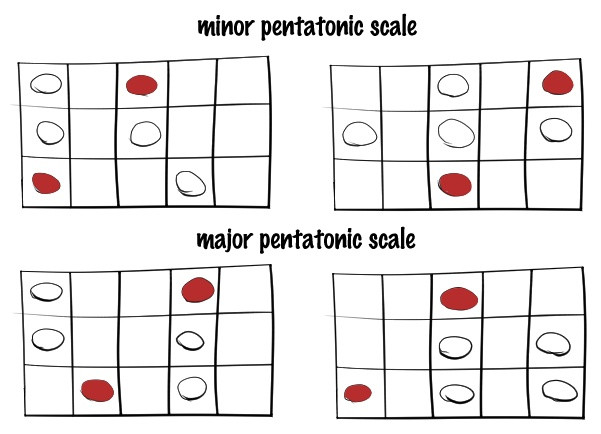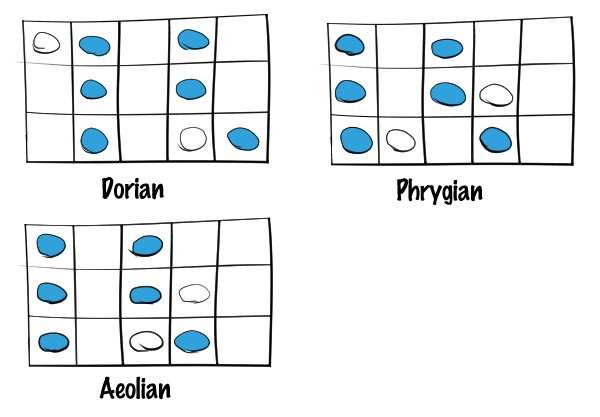Pentatonic scales are the secret weapon in every bassist’s arsenal. Spanning across genres from funk and blues to rock, reggae, and jazz, their universal appeal lies in their inherent musicality. These five-note scales are celebrated for their ability to effortlessly create pleasing sounds over a wide range of chords. If you’re ready to master pentatonic scales and inject their magic into your bass playing, you’ve come to the right place. This lesson will break down everything you need to know to start using pentatonics effectively.
Decoding Pentatonic Scales
At its core, a pentatonic scale is a five-note scale derived from either a major or minor scale. Among the variety of pentatonic scales, the major and minor pentatonic scales are fundamental for any bassist to learn. If terms like “major” and “minor” feel like a foreign language, it might be helpful to explore resources that explain chord construction to solidify your understanding.
The Major Pentatonic Scale is constructed using a specific formula of intervals: Root, Major Second, Major Third, Perfect Fifth, and Major Sixth. Conversely, The Minor Pentatonic Scale utilizes: Root, Minor Third, Perfect Fourth, Perfect Fifth, and Minor Seventh. The visual nature of the bass guitar fretboard is incredibly helpful in understanding these scales. Let’s visualize how these shapes lay out on your bass.
Pentatonic Scale Shapes on the Bass Fretboard
 Bass Guitar Minor and Major Pentatonic Scale Shapes
Bass Guitar Minor and Major Pentatonic Scale Shapes
Figure 1 – Visual fretboard diagrams for minor and major pentatonic scale shapes on bass guitar.
In these diagrams, the red note in each shape indicates the root note, the foundational note of the scale. For instance, playing the first shape shown, beginning on the note G, will produce a G minor pentatonic scale. The shapes presented in the right column are not new scales, but rather alternative fingerings for the same notes found in the left column, offering different playing experiences and positions on the neck. It’s beneficial to familiarize yourself with both sets of fingerings for each scale, as each can be more practical depending on the musical context.
Matching Pentatonic Scales to Chords: Major and Minor Harmony
Now that you’re acquainted with the shapes of both major and minor pentatonic scales, the crucial step is understanding their application. As a simple rule of thumb, the major pentatonic scale is your go-to choice for playing over major chords. Similarly, the minor pentatonic scale is ideally suited for improvising or creating bass lines over minor chords. Music theory, at its heart, often presents logical and straightforward relationships like this!
Pentatonic Scales and Their Connection to Modes
For those who have already explored the concept of modes, the pentatonic shapes presented in the left column of Figure 1 might look familiar. This is because pentatonic scales can be viewed as simplified versions of musical modes. If modes are still uncharted territory for you, feel free to skip this section for now and revisit it later. However, for those familiar with modes, let’s examine how the minor pentatonic scale relates to minor modes:
 Bass Guitar Minor Pentatonic Scale Relationship to Minor Modes
Bass Guitar Minor Pentatonic Scale Relationship to Minor Modes
Figure 2 – Illustration showing the notes of the minor pentatonic scale highlighted within different minor modes on the bass fretboard.
In these modal shapes, the notes that constitute the minor pentatonic scale are highlighted in blue. As you can observe, the notes of the minor pentatonic scale are present within each of the three primary minor modes. This concept extends to major modes and the major pentatonic scale as well. Experiment and see if you can identify these relationships yourself!
The Advantage of Multiple Pentatonic Fingerings
Earlier, we introduced two sets of shapes for each pentatonic scale. Mastering each shape is crucial because each one offers unique advantages in different musical situations on the bass. The shapes on the left side of Figure 1 are more compact, keeping your hand within a tighter fret range. However, they can be more challenging to play initially due to some finger stretches spanning three frets. Conversely, the shapes on the right are generally easier to finger, with no stretches greater than two frets. Employing slides strategically can further enhance the fluidity of playing these shapes. You’ll see practical examples of how to utilize these different fingerings when we explore playing bass lines using pentatonic scales.
Putting Pentatonic Scales into Practice
With a solid understanding of how to play pentatonic scales and when to use them, the next logical step is application. The most effective way to internalize any musical concept is by using it in a real-world musical scenario where it adds value.
 Chord Progression Example for Bass Pentatonic Practice
Chord Progression Example for Bass Pentatonic Practice
Figure 3. Example chord progression designed for practicing bass lines using pentatonic scales.
Above is a simple chord progression created to demonstrate pentatonic application. It includes three major chords: F, Bb, and C, and two minor chords: D minor and G minor. As discussed earlier, you can effectively use a major pentatonic scale over each major chord and a minor pentatonic scale over each minor chord within this progression.
Crafting a Bassline Using Pentatonic Scales: Step-by-Step
To create a bassline for this chord progression, you can follow these steps:
- Bar 1 (F Major): Use the F major pentatonic scale.
- Bar 2 (Bb Major): Use the Bb major pentatonic scale.
- Bar 3 (D Minor): Use the D minor pentatonic scale.
- Bar 4 (G Minor – first two beats): Use the G minor pentatonic scale.
- Bar 4 (C Major – last two beats): Use the C major pentatonic scale.
Example Bassline Demonstrating Pentatonic Scales in Action
 Chord Progression Example for Bass Pentatonic Practice
Chord Progression Example for Bass Pentatonic Practice
Figure 4 – Musical notation example of a bassline composed using pentatonic scales over the chord progression shown in Figure 3.
This example bassline demonstrates the practical application of pentatonic scales. Notice the varied fingerings of the pentatonic scales used throughout. Experiment to find which fingering feels most natural and efficient in different musical contexts. For instance, in the first bar, the second shape for the major pentatonic scale is used to avoid relying on open strings, showcasing a practical fingering choice.
Expanding Your Pentatonic Horizons: Further Exploration
For an additional example and deeper dive, check out this resource: The transcription is is available by clicking here.
Making Pentatonics Your Own
The true power of pentatonic scales unlocks when you start creating your own basslines. Begin by practicing over a single minor chord, then a major chord. Once you’re comfortable, challenge yourself by applying both minor and major pentatonic scales to chord progressions, similar to the exercise provided.
Hopefully, this guide has illuminated the path to using pentatonic scales in your bass playing. If you have any questions, insights, or suggestions regarding this lesson, please share them in the comments below.
